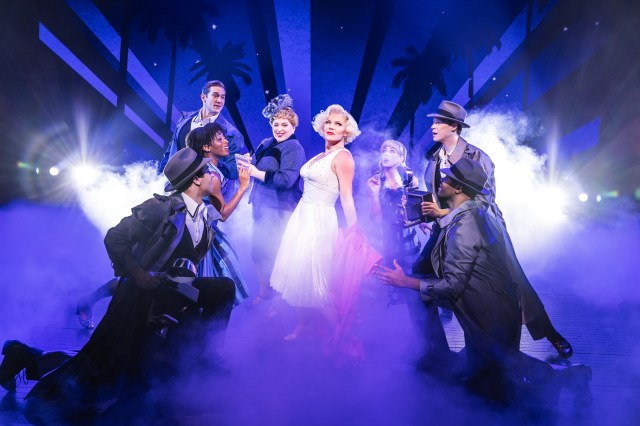
in Saving Aimee
(© Scott Suchman)
Saving Aimee, now enjoying its world premiere full production at Virginia’s Signature Theatre, is a high-energy jog through the life of evangelist Aimee Semple McPherson, a media superstar of the 1920s and 30s. It’s a rousing experience, thanks to a group of tour-de-force performances, especially from Tony Award nominee Carolee Carmello in the title role, and songs by Kathie Lee Gifford, David Pomeranz, and David Friedman that add layers of emotional shading missing from the dialogue played out between them. Director Eric Schaeffer’s deft hand maximizes the show’s strengths, fusing performers, songs, and story into an entertaining blend.
The show, which features a book and lyrics by Gifford, features a pastiche of rock-infused gospel, bluesy pop tunes, inspirational anthems, and plaintive ballads.
Some of the lyrics may sound like slogans, such as Aimee’s declaration, “You’re only down when you stand for nothing at all,” in the show’s robust opener, “Stand up!” or when teenaged Aimee chafes at parental restrictions in the invigorating “Why Can’t I?” by lamenting, “Why must I live with such inane authority?” But Gifford has crafted a captivating story with songs full of heart.
The challenge here is capturing the epic arc of Aimee’s life in two and a half hours. The charismatic preacher and faith healer did lots of living in her 54 years. She had three husbands, international adventures, and personal demons. She built a burgeoning ministry and created one of the first multi-media empires. Unfortunately, Gifford tries to squeeze it all in, with many life-changing events handled offstage and related through use of quick exposition or media headlines and broadcast snippets.
In the end, Aimee remains an enigma; we are never quite certain if she is a Godly woman, or a God-awful fake. Motivation for her most controversial actions, especially in her later years, remains murky. Does the suggestion in the title that Aimee needs “saving” offer a clue?
Carmello brilliantly plays off the ambiguity with a brassy, no-holds-barred performance. She captures the essence of a complicated, troubled woman from idealistic girlhood to dissolute middle age. One moment, her Aimee is fragile, clinging to strong men such as her loving father, and the next, she’s resolutely pushing aside each obstacle a male-dominated society puts in her way. She plays most of it big, her leather-lunged contralto dominating the 11 songs she sings with others or the ensemble. But she caresses three solos, and in “The Silent, Sorrowful Shadows,” Carmello masterfully conveys subtle shades of misery.
Carmello is matched by local favorite E. Faye Butler as Aimee’s friend and former madame, Emma Jo. The powerhouse singer alters the show’s pop-flavored ambiance with “A Girl’s Gotta Do What a Girl’s Gotta Do,” getting bluesy with an ensemble of prostitutes. Butler also kicks off act two with a rousing gospel number, “God Will Provide,” and she electrified the opening night audience with her solo “Emma Jo’s Lament.” Butler also provides earthy counterpoint to Carmello’s ethereal, often inscrutable Aimee, and ably tosses off such silly lines as “Some of these Christians are so pious, they really pious me off,” with a natural charm.
Ed Dixon plays two roles. As Aimee’s gentle father, his soft ballad, “Letter from Home” to his absent daughter is simple and sentimental. Later, Dixon plays Brother Bob, a sanctimonious, Jerry Falwell-like preacher who tries to muzzle the flamboyant evangelist. In a complete turnabout, Dixon is the epitome of spiteful malice in the song “Demon in a Dress.” Flo Lacey is Minnie, Aimee’s mother who initially resists but eventually serves her daughter’s ambitions. She sings the title song, “Saving Aimee,” a Sondheim-ish plea for Minnie’s increasingly wayward daughter to return to piety.
Schaeffer pushes the cast and crew to a rapid pace. Scene changes are frequently punctuated with loud bangs and extreme lighting changes, chased by melodramatic music chords. It creates a sense of life that’s out of control, buttressing Gifford’s expressive lyrics but thin dialogue.
Christopher d’Amboise’s tight choreography keeps the 19 cast members churning about the various levels of Walt Spangler’s spartan but versatile, wood-plank set. Bible verses and period newspaper headlines are projected onto the set, another layer of detail that fills out the story.
Bruce Coughlin’s charts are lustily played by 13 musicians perched high over Signature’s new MAX mainstage, conducted by Jenny Cartney. They’re apparently experimenting with sound here, and having the orchestra off to one side thins out the sound somewhat for people seated across the room. The actors are miked, but sound designer Robert Kaplowitz has apparently sought to maintain the natural sound of unamplified voices that is Signature’s heritage. The amplification is noticeable mostly in the big production numbers.
We may not really know Aimee Semple McPherson when Saving Aimee is over, but we will have enjoyed her company.








